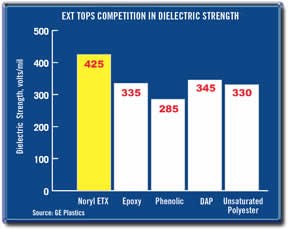PPO-Based Thermoset Holds Promise in BMC
A novel thermoset resin based on poly phenylene oxide (PPO) chemistry was unveiled last month at the NPE show by GE Plastics.
A novel thermoset resin based on poly phenylene oxide (PPO) chemistry was unveiled last month at the NPE show by GE Plastics. Noryl ETX is apt to see its first use in bulk molding compounds (BMC) under joint development by GE and Bulk Molding Compounds, Inc. Longer term, GE expects its new thermoset to find use in sheet molding compound (SMC) and resin transfer molding (RTM).
“ETX adds another dimension to PPO capability,” asserts Paul Hirt, global manager for Noryl PPO resins, who pegs it at the high end of the performance ladder for thermosets. ETX resin properties are said to surpass those of phenolics, unsaturated polyesters, vinyl esters, and epoxies. Early evaluation suggests that ETX offers potential in a number of applications where superior toughness at elevated temperature, outstanding dielectric properties, and low moisture pickup are critical.
Joseph Carfora, BMCI’s v.p. of new-business development, confirms that ETX-based BMCs improve toughness and ductility without compromising properties like heat and chemical resistance and dimensional stability. “Noryl ETX potentially carries BMCs in some exciting directions,” Cafora declares, citing automotive valve covers (currently in vinyl ester BMC), air-intake manifolds (mostly in reinforced nylon 66), and oil pans (mostly metal).
GE has begun marketing the new BMCs on a global basis. BMCI’s role in this co-development effort is to provide formulating, molding, and application expertise and to manufacture the compounds at its production facilities. Noryl ETX-based BMCs are offered in standard dough-like form and reportedly can be dropped into existing BMC processing equipment.
Formulating flexibility
Benny David, GE’s global marketing manager for composites, describes Noryl ETX as a true thermoset that retains many inherent PPO properties, such as high toughness and strength. Another is low moisture pickup—somewhat lower than for vinyl ester and much better than for unsaturated polyester.
The basic building block is a proprietary PPO resin that is chemically functionalized so that it crosslinks during the thermoset cure cycle. This functionalized PPO is dissolved in styrene or another monomer to get a liquid analogous to the ones used to make existing BMCs.
Noryl ETX properties can be tailored by selecting PPOs of particular molecular weights, changing the PPO use level over a range of 5% to 70%, or dialing in varying degrees of crosslinking.
Noryl ETX reportedly imparts electrical properties comparable to costlier materials like fluoropolymers, polyimides, porcelain, and epoxies. GE’s David says ETX’s strength lies in its excellent balance of low dissipation factor, low dielectric constant, and high dielectric strength. For instance, Noryl ETX reportedly outperforms all existing thermosets in resistance to voltage breakdown (see graph).
These properties make Noryl ETX a potential candidate for under-hood applications that BMCI is investigating. Some of these (e.g., valve covers) have already been prototyped. Future EXT-based BMCs and RTM compounds that are tougher, more dimensionally stable, and even more moisture-resistant could be an option for bipolar plates used in fuel-cell stacks. Rival materials in this emerging market are vinyl ester-based BMCs, carbon-fiber/epoxy compounds, and high-temperature thermoplastics like liquid-crystal polymers. Potentially, Noryl ETX thermosets could also carve roles in capacitors and circuit breakers as a replacement for porcelain and epoxies.
Large structural composites, including engine and windmill blades, are another promising sector. Windmill blades are currently made using metal or RTM, but their size (up to 200 ft long) makes a material like ETX attractive. The new thermoset potentially brings higher strength, increased dimensional stability, and lighter weight.
Applications where electrical performance is critical are also targeted. One is semiconductor chip encapsulants, where ETX could provide improved dielectrics, lower moisture absorption, and reduced stress cracking compared with epoxy incumbents.
Read Next
Lead the Conversation, Change the Conversation
Coverage of single-use plastics can be both misleading and demoralizing. Here are 10 tips for changing the perception of the plastics industry at your company and in your community.
Read MoreProcessor Turns to AI to Help Keep Machines Humming
At captive processor McConkey, a new generation of artificial intelligence models, highlighted by ChatGPT, is helping it wade through the shortage of skilled labor and keep its production lines churning out good parts.
Read MoreAdvanced Recycling: Beyond Pyrolysis
Consumer-product brand owners increasingly see advanced chemical recycling as a necessary complement to mechanical recycling if they are to meet ambitious goals for a circular economy in the next decade. Dozens of technology providers are developing new technologies to overcome the limitations of existing pyrolysis methods and to commercialize various alternative approaches to chemical recycling of plastics.
Read More























